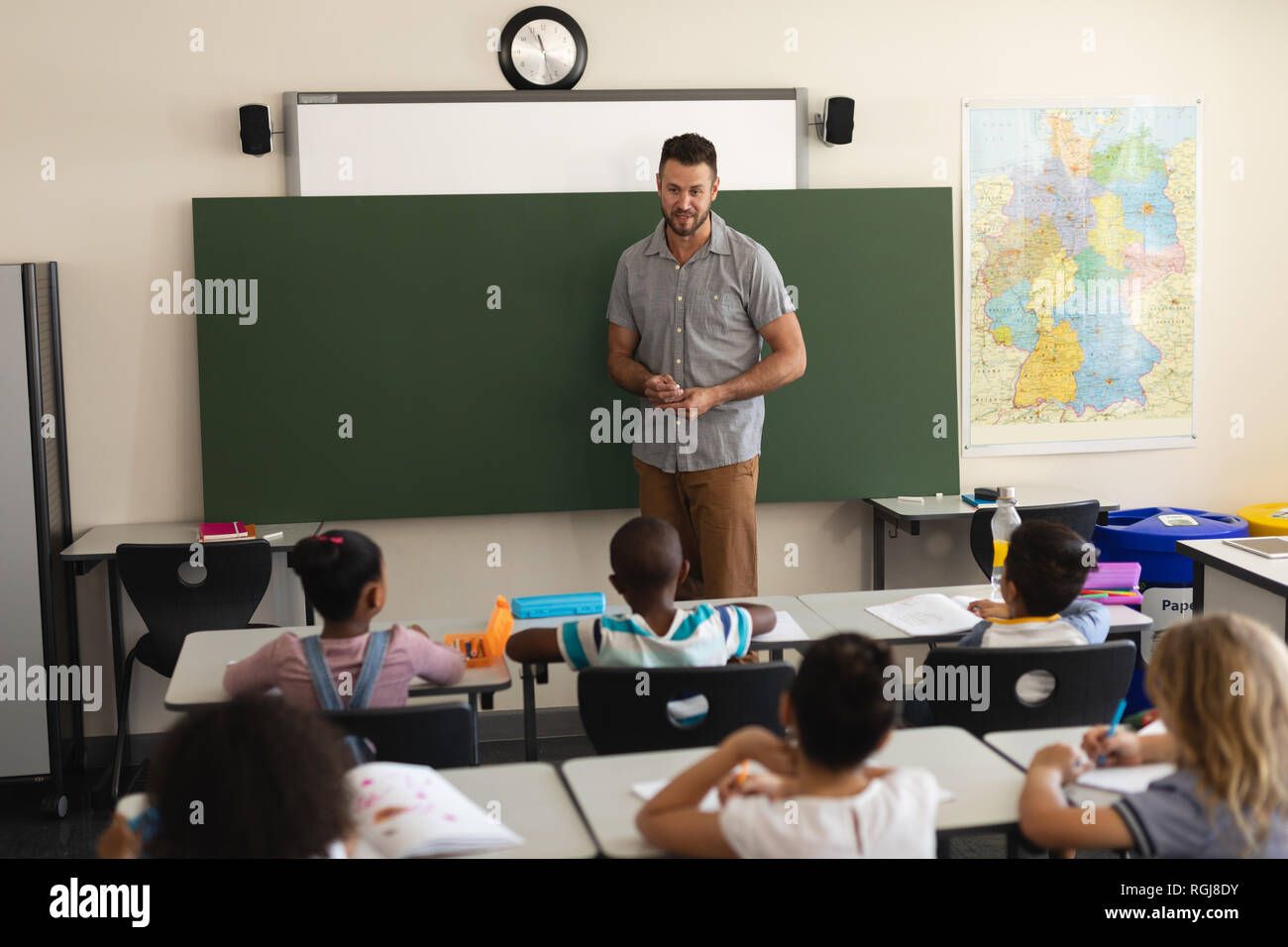Accelerate Learning with Primary Science Tuition Singapore for Young Minds
Accelerate Learning with Primary Science Tuition Singapore for Young Minds
Blog Article
A Comprehensive Overview to the Numerous Understanding Techniques in Main Science Instruction
The expedition of varied understanding methods in primary science guideline offers a chance for teachers to enhance trainee engagement and understanding dramatically. By examining hands-on knowing methods, inquiry-based techniques, and joint approaches, we can recognize efficient practices that deal with various learning designs. Furthermore, the integration of modern technology and separated instruction plays a crucial function in fostering an inclusive setting. The inquiry remains: exactly how can these approaches be efficiently carried out in the classroom to optimize their effect? The solution lies in a better analysis of each approach and its ramifications for mentor science.

Hands-On Learning Strategies
Hands-on learning methods play an essential duty in key science instruction, engaging trainees in active exploration and testing. These approaches permit students to connect straight with sensations and materials, cultivating a much deeper understanding of clinical concepts. By utilizing manipulatives, models, and real-life experiments, educators create an environment where pupils can observe, assume, and test their concepts.
Such strategies not just boost understanding however likewise cultivate essential thinking and analytic abilities. When pupils get involved in activities like developing easy machines, planting seeds, or conducting chemical responses, they are urged to ask concerns and seek answers via their very own observations. This experiential approach aids to debunk complex clinical concepts, making them much more relatable and available.
Furthermore, hands-on learning advertises partnership among peers, as pupils commonly operate in teams to carry out experiments or share findings. This synergy not only improves their knowing experience but likewise develops crucial social skills. Inevitably, integrating hands-on techniques in main science direction fosters a long-lasting love of learning and interest about the all-natural globe, laying a strong structure for future scholastic quests in scientific research and beyond.
Inquiry-Based Discovering
Inquiry-based learning is a training approach that motivates pupils to ask questions, check out phenomena, and build their very own understanding of clinical concepts. This technique changes the focus from standard teacher-led guideline to a more student-centered experience, where students take the campaign in their educational journey. By cultivating curiosity, inquiry-based knowing advertises much deeper involvement with the product, allowing trainees to discover subjects in a meaningful context.
In practice, this technique usually involves hands-on experiments, observations, and vital reasoning tasks that straighten closely with the scientific technique. Trainees are motivated to develop hypotheses, style examinations, and assess data, which grows important skills such as logical and analytic thinking. The duty of the instructor in this structure is to promote expedition, guiding students through the inquiry procedure while urging independent idea and partnership.
Additionally, inquiry-based discovering supports a sense of possession over the understanding procedure, inspiring trainees to pursue expertise proactively. This technique not just boosts understanding of clinical ideas but also cultivates a long-lasting love for knowing, gearing up pupils with the abilities essential to browse a significantly complicated world.
Collaborative Learning Approaches
Collaborative discovering techniques empower trainees to involve in meaningful interactions with peers, promoting view website a common responsibility for their academic results. In key science direction, these methods urge learners to interact to discover clinical principles, solve problems, and carry out experiments (primary science tuition Singapore). By joining team activities, students can leverage diverse point of views, enabling for richer understanding and retention of clinical understanding
One secret facet of joint understanding is the focus on interaction abilities. Pupils have to express their ideas, pay attention proactively to others, and discuss ideas, every one of which are important expertises in both real-world and academic contexts. This social interaction not Homepage just boosts their understanding of clinical concepts however likewise promotes teamwork and conflict resolution abilities.
When students see the worth of their payments within a group, they are extra most likely to take ownership of their discovering journey. Generally, including collective understanding methods in key scientific research direction grows a dynamic understanding atmosphere that prepares pupils for future scholastic and social challenges.
Innovation Assimilation in Science
The combination of modern technology in primary scientific research direction improves finding out experiences by providing ingenious devices and sources that sustain numerous teaching approaches, consisting of collaborative knowing - primary science tuition Singapore. The usage of electronic platforms, simulations, and interactive applications enables trainees to involve deeply with clinical principles, helping with a much more hands-on approach to discovering
Online research laboratories, as an example, make it possible for students to perform experiments securely and efficiently, promoting inquiry-based learning. These devices can simulate real-world scientific scenarios, allowing students to visualize complex procedures that would certainly be hard to reproduce in a traditional classroom setup. In addition, modern technology cultivates interaction and partnership among students, as they can share findings and function with each other on tasks via on-line systems.
Additionally, multimedia presentations and instructional video clips can enhance lessons by accommodating diverse understanding designs, making abstract ideas much more available. Information analysis devices likewise empower students to collect and translate clinical data, strengthening essential believing skills. Generally, the tactical incorporation of innovation in primary scientific research guideline not just improves engagement yet also prepares pupils for a technically advanced society, equipping them with essential abilities for future clinical endeavors.
Distinguished Instruction Techniques
Separated direction techniques are crucial for addressing the varied requirements of students in primary science education and learning. These techniques enable instructors to customize their mentor approaches to fit differing capacities, passions, and learning styles within the classroom. By employing separated direction, educators can develop here a comprehensive atmosphere that cultivates involvement and enhances understanding of scientific principles.
One reliable method is to use flexible grouping, which permits pupils to team up with peers at comparable skill levels or with differing viewpoints. This technique urges peer knowing and advertises critical reasoning. In addition, providing options in tasks can empower pupils, allowing them to select jobs that reverberate with their interests while still meeting curricular objectives.
Furthermore, incorporating tiered assignments is one more important technique. Deliberately tasks with varying levels of intricacy, instructors can make sure that all pupils are properly tested, despite their effectiveness. Utilizing formative analyses to determine comprehending further allows teachers to adjust their instructional techniques dynamically, ensuring that each student receives the support they need.
Inevitably, implementing set apart guideline techniques in primary science education not just enhances student understanding end results however likewise cultivates an enthusiasm for science, preparing pupils for future scholastic searches.

Conclusion
In summary, efficient main scientific research direction necessitates a complex strategy that includes hands-on learning, inquiry-based approaches, and collective techniques. The assimilation of technology and distinguished direction even more provides to varied discovering styles, cultivating a setting helpful to exploration and important reasoning.
The expedition of diverse understanding approaches in primary scientific research guideline offers a possibility for teachers to boost trainee engagement and understanding substantially.Hands-on understanding strategies play a pivotal function in key science instruction, engaging students in energetic exploration and experimentation.Inquiry-based learning is a training technique that encourages students to ask concerns, investigate sensations, and create their very own understanding of scientific concepts.Collective knowing strategies empower pupils to engage in meaningful interactions with peers, promoting a shared duty for their instructional outcomes. Generally, incorporating collective discovering methods in main science instruction cultivates a dynamic learning environment that prepares pupils for future academic and social obstacles.
Report this page